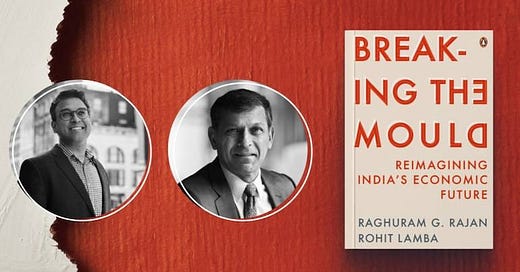Critique of Raghuram Rajan's Economic Perspectives and Underlying Motivation
"Pardon him for he is just trying to peddle his new book that no one may read outside India."
Questioning the Motives of Hon’ble Raghuram Rajan
It seems every time Raghuram Rajan surfaces in the Indian media, it's conveniently timed with the launch of his new book. His recent appearances alongside Rohit Lamba for their book "Breaking the Mould" follow this pattern. One can't help but wonder if Rajan's criticisms of the Indian government's policies are more about grabbing attention and stirring controversy for book promotion rather than offering genuine economic insights and viable solutions.
Arm-Chair Criticism Without Viable Alternatives
Raghuram Rajan and Rohit Lamba's assessment of India's focus on infrastructure and low-skilled manufacturing is notably superficial, lacking the depth and understanding of India's complex economic fabric. Their advocacy for a pivot towards IT-enabled services and Intellectual Property Rights (IPRs) overlooks the nuanced dynamics of India's multifaceted economy. More critically, their analysis seems to ignore the burgeoning influence of Artificial Intelligence (AI), a technological revolution set to drastically reshape various sectors, including IT services. This omission not only highlights a gap in their understanding but also casts their arguments as theoretical musings detached from practical, actionable solutions. Their approach, more akin to arm-chair criticism, lacks the depth and foresight needed to navigate the rapidly evolving economic landscape.
Unfounded Generalizations: Gurugram and Noida work like ‘First-World Economies’; rest is like Sub-Saharan Africa
Raghuram Rajan's characterization of Gurugram and Noida as mirroring "First-World Economies," contrasted with his comparison of the rest of India to Sub-Saharan Africa, starkly oversimplifies India's intricate socio-economic fabric and seems to arise from a poorly informed perspective. This viewpoint overlooks critical issues such as the deteriorating civic infrastructure, severe traffic congestion, high crime rates, and alarmingly poor air quality in these cities of the NCR, factors which are hardly indicative of 'First-World' status. The assertion that real estate dealings in these areas predominantly involve substantial amounts of unaccounted cash further undermines the notion of their supposed advanced economic standing. Such a depiction, neglecting the complexities and challenges present in these urban centers, casts doubt on the accuracy of Rajan's assessment of India's diverse economic landscape.
It's also worth pondering when Rajan last ventured beyond the metropolitan bubbles of Mumbai and Delhi to witness the diverse realities of India's vast rural and semi-urban areas. His observations, lacking in nuance and depth, not only seem out of touch with the ground realities of these regions but also border on being maliciously misleading. Such sweeping generalizations fail to recognize the incremental progress and varied challenges across different parts of India, painting an inaccurate and overly simplistic picture of a nation that is anything but homogeneous in its economic and social fabric.
Overemphasis on Theoretical Perspectives
Rajan's approach to Indian economic issues often seems detached from the ground realities, leaning heavily on theoretical constructs. His criticisms of initiatives like demonetisation and the PLI scheme lack a nuanced understanding of India's unique socio-economic fabric. There's a sense that his viewpoints are shaped more by his academic environment rather than the practical needs of the Indian economy.
Misplaced Overreliance on Foreign Credentials
The Illusion of Foreign Expertise in Indian Economic Policy
There is a persistent and perplexing tendency to overvalue foreign academic credentials in the realm of economic policy-making in India. This reverence raises the question: Why is a degree from an overseas institution and a position in an average American university seen as the pinnacle of wisdom to guide India's unique economic path? The lack of significant mention of such individuals in the international media or in discussions about major economies like the U.S., Argentina, or China, further diminishes their supposed global economic repute. If these economists were indeed of such stature, one would expect their insights to be sought after globally, influencing how the U.S. Federal Reserve tackles inflation or how China addresses its housing loan crisis.
Questioning the Disconnect with Ground Realities
Out-of-Touch Economic Perspectives and the Missed AI Revolution
Raghuram Rajan's stance against India embracing the manufacturing sector, favoring instead a reliance on the services industry, seems out of touch with the evolving global economic landscape. By advocating for a service-centric approach, there's a risk of relegating Indian workers to low-value, outsourced roles, essentially becoming 'cyber coolies' whose efforts enrich foreign corporations more than their own economy. Moreover, Rajan's apparent oversight of the revolutionary advances in artificial intelligence is startling. In a world where AI and automation are poised to redefine job roles, including those in the IT sector, his failure to address this paradigm shift borders on economic illiteracy. It's concerning that an economist, expected to be at the forefront of economic thought, seems to overlook these critical trends, instead reverting to outdated mantras that do not align with the realities of the global tech economy.
Overlooking the Agricultural Sector's Complexities and Potential
Neglecting the Backbone of India's Economy: Agriculture and Allied Sectors
Raghuram Rajan's analysis notably sidesteps the intricacies and significance of the agricultural sector, a cornerstone of the Indian economy. His silence on critical issues like agricultural marketing, the control of import and export of agricultural commodities, and the Minimum Support Price (MSP) system reflects a glaring oversight. Agriculture, supporting a vast majority of the Indian population, demands nuanced attention, especially in the context of evolving global trade dynamics and climate change challenges. Additionally, Rajan's lack of commentary on innovative schemes like MNREGA (Mahatma Gandhi National Rural Employment Guarantee Act), which has a profound impact on rural livelihoods and labor reforms, further demonstrates a disconnect from grassroots realities. These omissions suggest a lack of appreciation for the sector's potential in driving sustainable economic growth and the need for tailored policies that cater to the diverse, often complex, rural landscape of India.
Ignoring the Vibrancy of Indigenous Startups and Labor Reforms
Underestimating India's Entrepreneurial Spirit and Workforce Dynamics
Equally conspicuous in Rajan's critiques is the absence of discussion around the burgeoning indigenous startup ecosystem and labor reforms, pivotal elements in shaping India's economic future. Startups in India have been at the forefront of innovation, driving technological advancements and creating new job opportunities. Yet, Rajan's narrative seems oblivious to the entrepreneurial zeal and the transformative potential of these startups, especially in sectors like technology, healthcare, and education. Furthermore, his silence on labor reforms, a critical aspect for both economic growth and social equity, indicates a lack of engagement with policies that directly impact the workforce. These reforms are essential in balancing the rights of workers with the needs of a rapidly evolving economy. By overlooking these vital areas, Rajan misses the chance to contribute to a discourse that is central to India's journey towards becoming a modern, innovative, and equitable economy.
Criticism Without Constructive Alternatives
Rajan's One-Dimensional Approach to Policy Analysis
Raghuram Rajan's approach to critiquing India's economic policies consistently reveals a tendency to highlight shortcomings without offering viable, practical alternatives. This method contributes little to constructive economic discourse, as it leans towards identifying problems rather than providing solutions. Where Rajan does propose alternatives, they often come across as one-dimensional and lack a comprehensive analysis of their potential ripple effects across interconnected sectors and the global economy. His suggestions fail to consider the intricate balance and interplay between domestic economic strategies and international market dynamics. Such a narrow viewpoint is insufficient in addressing the multifaceted challenges of a complex and rapidly evolving global economic environment.
Overlooking Geopolitical Realities and the Role of the Indian Diaspora
Ignoring the Broader Context in Economic Strategies
Furthermore, Rajan's critiques and proposed policies miss critical factors such as geopolitical realities and the influential role of the Indian diaspora. In today's interconnected world, economic strategies cannot be evaluated in isolation; they must be contextualized within the broader geopolitical landscape. Geopolitical constraints and opportunities play a pivotal role in shaping economic policies, especially for a country like India, which is strategically positioned on the global stage. Additionally, Rajan's analysis disregards the significant impact and potential contributions of the Indian diaspora. This vibrant community, with its global presence and connection to India, can be a powerful asset in driving foreign investment, technology transfer, and international diplomacy. By not incorporating these crucial elements into his economic discourse, Rajan overlooks key drivers that are essential for crafting holistic and effective economic strategies.
Summing Up: “Don’t Junk India’s Image Merely Because You want to Sell Your New Book”
While Raghuram Rajan's academic achievements and international exposure may be commendable in his self-assessment, his critiques of India's economic policies often lack practicality and relevance to India's unique context. His arm-chair analysis and failure to propose viable solutions make his contributions less impactful for meaningful economic discourse. The need of the hour is a more grounded, pragmatic approach to economic policy-making that considers the realities of India's diverse and complex economy.
While Raghuram Rajan's book might achieve commercial success, the ideas it espouses risk falling short of resonating with contemporary economic realities. His perspectives come across as outdated and anachronistic, particularly in light of the transformative advancements in fields like Artificial Intelligence (AI). This gap renders his insights less relevant in an era where AI is drastically reshaping global industries and economies. Moreover, Rajan’s tendency to play the role of a modern-day Cassandra, forecasting doom for India’s economy without acknowledging the nuanced interplay of technology and market dynamics, further detracts from the practical applicability of his viewpoints. For his analyses to be more than just cautionary tales and to truly impact economic strategies, they need to evolve with a deeper understanding of current and emerging technological innovations, reflecting a balanced perspective that integrates both challenges and opportunities in the rapidly advancing economic landscape.






"Great job! This article should be shared widely to challenge these self-absorbed armchair economists. Your perspective is important, and I hope it gets the attention it deserves."
There are many dimensions to Rajan’s new book. It will be unfair for me to offer comments merely based upon reviews or TV talks. But I want to say something about PLI which mostly plays in mobile sector.
We harp on rise in exports which is erroneous. Since we do only assembling, we import all its parts. Therefore, the crucial data is Net exports in mobile sector. It is worth noting that net exports (exports minus imports) of mobile phones and components have fallen in the previous 5 years. Govt needs to explain this fall. Is it the case that we have become more dependent on imports despite PLI regime?
Since the value added is so minuscule, we are not sure whether India is paying out more in subsidies and tax concessions than the value added in India. Government should come out with transparent data.